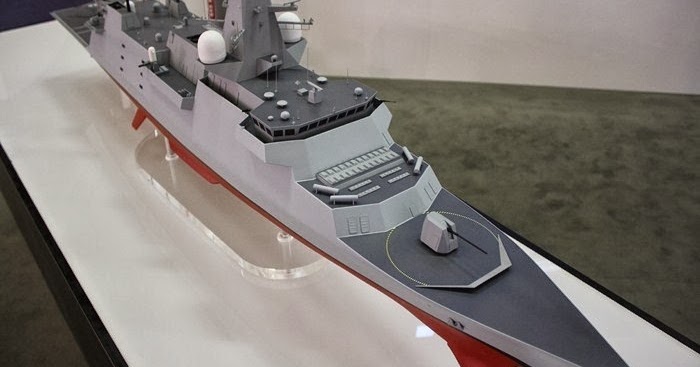Turkey to make its own maritime missile-launching system after sanctions interrupt Lockheed plans
By: Tayfun Ozberk
MERSIN, Turkey — Turkish defense company Roketsan is to develop a vertical launching system for the country’s first locally made frigate, after American sanctions disrupted original procurement plans, said naval platforms acquisition official Alper Kose.
The future MDAS, which stands for Milli Dikey Atis Sistemi (or in English, National Vertical Launch System), is to equip the TCG Istanbul, the lead ship of Turkey’s I-class frigates. Turkey’s top defense procurement official, Ismail Demir, had announced Jan. 23 at the warship’s launch ceremony that the vessel would be fitted with an indigenous VLS. Until now it was unclear who would manufacture the national missile launching system and what would be its specifications.
The government initially planned to install the Mk 41 VLS, made by American firm Lockheed Martin. However, sanctions imposed on Turkey through the U.S. Countering America’s Adversaries Through Sanctions Act prevented the sale of the MK 41 VLS. The U.S brought about the sanctions after Turkey bought the Russian S-400 air defense system.
Kose, who leads the naval platforms unit at the defense procurement agency Presidency of Defence Industries, or SSB, said the government hired missile-manufacturer Roketsan to develop MDAS.
“The FMS was not approved for using the U.S.-made Mk 41 as a vertical launch system for the Milgem [naval project’s] fifth ship. Thus, we inked an agreement with Roketsan and rearranged the contract so that Roketsan will develop the VLS,” Kose told Turkish media.
A source with a subcontractor working on the project told Defense News that the MDAS will be similar to the Mk 41. “However, it has some structural differences, like its height. MDAS will be 8 meters long — 30 centimeters longer than Mk 41,” the source said on condition of anonymity.
“The system will be capable of embarking and launching indigenous missiles, including HİSAR surface-to-air missile family ... and ATMACA anti-ship missiles,” the source added. “Turkey has gained enough know-how experience to develop an indigenous missile-launching system in the last decade. We have been working on the MDAS project and aim to make it ready before the acceptance trials of TCG Istanbul.”
MDAS was initially planned to equip the future TF2000-class air warfare destroyer, scheduled to enter service with the Turkish Navy by 2027. However, the plans changed as a result of the sanctions, and the SSB accelerated the project. According to the SSB’s agenda, the first I-class frigate is expected to be commissioned in 2023.
MDAS variants are expected to launch two Turkish weapons currently undergoing tests: the long-range air defense missile Siper, or Hisar-U; and the cruise missile Gezgin meant for tactical land-attack missions.
https://www.defensenews.com/industr...ource=twitter.com&utm_campaign=Socialflow+DFN
By: Tayfun Ozberk
MERSIN, Turkey — Turkish defense company Roketsan is to develop a vertical launching system for the country’s first locally made frigate, after American sanctions disrupted original procurement plans, said naval platforms acquisition official Alper Kose.
The future MDAS, which stands for Milli Dikey Atis Sistemi (or in English, National Vertical Launch System), is to equip the TCG Istanbul, the lead ship of Turkey’s I-class frigates. Turkey’s top defense procurement official, Ismail Demir, had announced Jan. 23 at the warship’s launch ceremony that the vessel would be fitted with an indigenous VLS. Until now it was unclear who would manufacture the national missile launching system and what would be its specifications.
The government initially planned to install the Mk 41 VLS, made by American firm Lockheed Martin. However, sanctions imposed on Turkey through the U.S. Countering America’s Adversaries Through Sanctions Act prevented the sale of the MK 41 VLS. The U.S brought about the sanctions after Turkey bought the Russian S-400 air defense system.
Kose, who leads the naval platforms unit at the defense procurement agency Presidency of Defence Industries, or SSB, said the government hired missile-manufacturer Roketsan to develop MDAS.
“The FMS was not approved for using the U.S.-made Mk 41 as a vertical launch system for the Milgem [naval project’s] fifth ship. Thus, we inked an agreement with Roketsan and rearranged the contract so that Roketsan will develop the VLS,” Kose told Turkish media.
A source with a subcontractor working on the project told Defense News that the MDAS will be similar to the Mk 41. “However, it has some structural differences, like its height. MDAS will be 8 meters long — 30 centimeters longer than Mk 41,” the source said on condition of anonymity.
“The system will be capable of embarking and launching indigenous missiles, including HİSAR surface-to-air missile family ... and ATMACA anti-ship missiles,” the source added. “Turkey has gained enough know-how experience to develop an indigenous missile-launching system in the last decade. We have been working on the MDAS project and aim to make it ready before the acceptance trials of TCG Istanbul.”
MDAS was initially planned to equip the future TF2000-class air warfare destroyer, scheduled to enter service with the Turkish Navy by 2027. However, the plans changed as a result of the sanctions, and the SSB accelerated the project. According to the SSB’s agenda, the first I-class frigate is expected to be commissioned in 2023.
MDAS variants are expected to launch two Turkish weapons currently undergoing tests: the long-range air defense missile Siper, or Hisar-U; and the cruise missile Gezgin meant for tactical land-attack missions.
https://www.defensenews.com/industr...ource=twitter.com&utm_campaign=Socialflow+DFN










